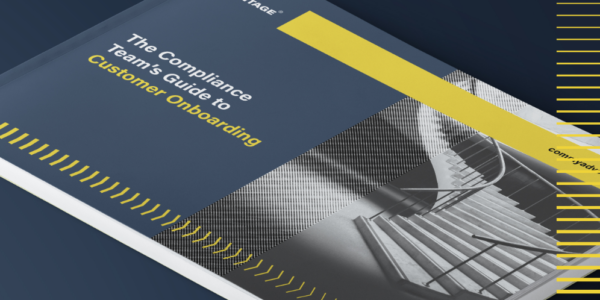

Traditional AML systems are falling behind against evolving threats: a smarter approach to AML compliance is needed. Read on to discover an AML compliance checklist that will enable robust compliance within your organization.
AML is at the heart of the compliance function but financial institutions around the world still struggle with a range of efficiency challenges. There are plenty of ways that traditional approaches to the AML compliance process can drag the function down: poor implementation, expanding regulation, administrative complexity, false positives, and worse, false negatives, all quickly consume the time and attention of compliance officers. Over time, dealing with unnecessary AML workloads wastes resources, saps employee morale and, if threats aren’t properly remediated and reported, exposes firms to potential criminal penalties. It’s important to explore the ways that Smart AML can practically and positively impact the compliance function and our AML compliance checklist is a great first step.
In this increasingly challenging environment, financial institutions need to think differently about AML compliance, implementing solutions that are rigorous enough to satisfy their regulatory responsibilities but nimble and efficient enough to detect and address evolving criminal methods.
Fortunately, there is an answer to the modern AML compliance challenge: Smart AML.
What does “smart AML” mean?
Smart AML repositions the compliance function, going beyond the need to simply observe and meet regulatory standards by taking a data-centric approach backed by the latest advances in technology. The Smart AML approach utilizes specialized tools and resources, configured to each financial institution’s risk profile, the demands of regulators, and the customer experience.
AML compliance checklist
At the heart of Smart AML is the notion of solving old problems with new tools. From enhancing onboarding to reporting suspicious activity to the authorities, financial institutions must understand the possibilities of a technology and data-centric approach to the AML compliance process before they can exploit its potential.
With that in mind, let’s explore the ways that Smart AML can practically, and positively, impact the compliance function using an AML compliance checklist.
1. Onboarding efficiency
In every financial institution, onboarding is a crucial component of both AML concerns and customer experience. If the process is slow or fraught with unnecessary delays, customers are likely to go elsewhere, but if the process isn’t intensive enough compliance may be jeopardized. To that end, Smart AML technology can consolidate multiple data sets and significantly reduce screening noise – delivering a significant efficiency impact during onboarding.
Smart Screening: Smart technology lets you tailor your screening process to the specific risk profiles of your clients. Practically that involves:
- Setting up specific risk segments for different customer groups during onboarding.
- Increasing efficiency by screening against select currencies and Politically Exposed Person (PEP) lists while eliminating others.
- Configuring compliance solutions to address common screening challenges, like equivalent naming conventions, and incorporating fuzzy logic solutions to capture idiomatic exceptions.
- Using multi-directional RESTful APIs to carry out checks in real-time. Smart automation ensures payments are processed compliantly and efficiently – reducing the burden on employees.
2. Progressive screening
Rather than a one-off, box-ticking exercise to be completed and signed-off, Smart AML transforms compliance into an ongoing process which continues throughout the client lifecycle, evolving with the threat landscape around it.
This capability gives firms the power to begin progressive payment screening. Aided by up-to-date data and automated tech, progressive payment screening goes beyond the usual onboarding check limits by instead continuing to perform AML compliance checks when the client engages in certain activities or payment types. In practice, progressive screening involves:
- Generating a check when a customer makes their first payment, or when a particular transaction crosses a value threshold.
- Checking when customers exhibit out-of-the-ordinary financial behaviour, like sending money to a foreign country.
- Incorporating adverse media checks into the screening process to increase the contextual information available.
False Positives
Traditional AML compliance best practises often generate significant slowdown during screening thanks to the sheer volume of data that has to be analyzed. The smallest errors in calibration can result in more false positives. Smart AML technology delivers an advantage here, too, since it lets firms isolate and monitor small batches of transactions, and ensure that both the volume and quality of generated alerts are appropriate for the risk profile. Therefore, it can reduce false positives.
3. Ongoing risk monitoring
In the past, if risk exposure changed, a company might have had to wait until it refreshed its compliance processes before it became aware of the issue. The advantage of smart AML is that it can be calibrated to adapt to the threat landscape, providing firms with a way to handle risks proactively and remain compliant even when the environment around them changes. Not only does this help firms streamline their normal KYC refresh processes but eliminate the unwelcome surprise of discovering compliance problems only when the regulators call.
Smart AML technology enables firms to react to changes affecting:
- Sanctions Lists: In a shifting geopolitical climate sanctions lists change quickly, meaning you may need to take steps to stop payments going through.
- PEP Lists: Your clients may participate in elections at every level of politics. If their status changes they may need to be added to a PEP list.
- Adverse Media: When news breaks, your compliance solution should be calibrated to keep pace with developing headlines.

Read our Guide to Customer Onboarding
This 5-part training series is designed to enable you to mitigate risks you may encounter during the customer onboarding process. Learn more and earn a certificate at the end.
Read the Guide4. Remediation and reporting
Configured to the individual needs of your firm, smart AML can significantly reduce noise and false positives but it obviously won’t eliminate money laundering threats completely, or indeed the need to deal with them. Fortunately, smart technology can also impact the way you make decisions about the money laundering threats you face, speeding up the way you remediate and report, generating meaningful insights, and passing efficiency benefits on to clients.
Smart AML solutions incorporate contextual data and automation to speed the decision-making process while connecting with other platforms in order to further streamline. When a client breaks a rule by doing business in a foreign country, for example, their KYC profile, informed by reactive, smart technology, may have already indicated their plans to expand – meaning your firm can react quickly to remediate and report the alert.
The remediation and reporting advantages of smart AML include:
- Audit trails: The ability to generate a clear audit trail means you’ll have all the necessary information lined up and ready to go should you need to action a suspicious activity report.
- Escalation and communication: Ensure your AML tools let you escalate your suspicious activity reports quickly – and, just as importantly, communicate clearly with your compliance team.
How do you measure the impact of smart AML?
A technology and data-centric approach to AML has a meaningful impact on businesses. Smart AML manifests itself in the customer experience and in the time saved during the compliance process – it has real-world effects.
Case Study: A firm with screening alert match rate of 22% had its compliance officers working on each alert for around five minutes, for a combined total of 40 hours a week. Transitioning to a Smart AML approach, and tailoring screening criteria to the risk profiles of its customer segments, the firm was able to reduce both the remediation time and workload for its employees. With the new approach, remediation time was reduced to three hours a day or less, which meant employees’ time and focus could be redirected into the business.
Firms can gauge the success of smart technology implementation using criteria which track with their AML compliance checklist:
- Onboarding: Has Smart AML reduced the time taken to complete onboarding? Has the payment process been optimized?
- False Positives: Has the false positive rate, and the time taken to reduce false positives, decreased?
- True Positives: Has it become easier and quicker to spot false positives? Is it easier and quicker to spot outliers?
- Internal Processes :Has the new approach reduced unnecessary work and optimized compliance skills and resources?
- Sourcing Data: Since data is crucial to Smart AML, firms should carefully consider the provider they use to source it. Four factors broadly determine the quality of AML data:
- Scope: Ensure your data provider covers the range of risks that your regulator needs you to screen against. Similarly, the scope of that provider’s data may need to span the world and a variety of languages.
- Depth: The data you use in your AML solution should be rich and detailed. Client profiles should be reinforced with numerous identifiers, such as birth dates and nationalities, or even include photographs.
- Reactiveness: Your data should be agile and updated regularly to reflect status changes like PEPs leaving office or the introduction of new international sanctions.
- Consolidation: Clean, consolidated data profiles mean you won’t have to work the same alert over multiple profiles – and ultimately make remediation quicker and easier.
Embracing change
Smart AML is only effective as a convergence of technology and data, and the will of financial institutions to transform their compliance function. Embracing the smart approach is a way to empower compliance, and compliance teams, in an often-confusing threat landscape – and means treating compliance as a living, breathing process which can grow and change with the needs of institutions and their customers. Most importantly, Smart AML should be an option for companies of every size, from established international banks to fledgeling start-ups. The only obligation Smart AML places on its users is a desire to innovate and embrace change.
Request a demo
See how 1000+ leading companies are screening against the world's only real-time risk database of people and businesses.
Demo requestOriginally published 06 June 2019, updated 18 October 2024
Disclaimer: This is for general information only. The information presented does not constitute legal advice. ComplyAdvantage accepts no responsibility for any information contained herein and disclaims and excludes any liability in respect of the contents or for action taken based on this information.
Copyright © 2025 IVXS UK Limited (trading as ComplyAdvantage).
